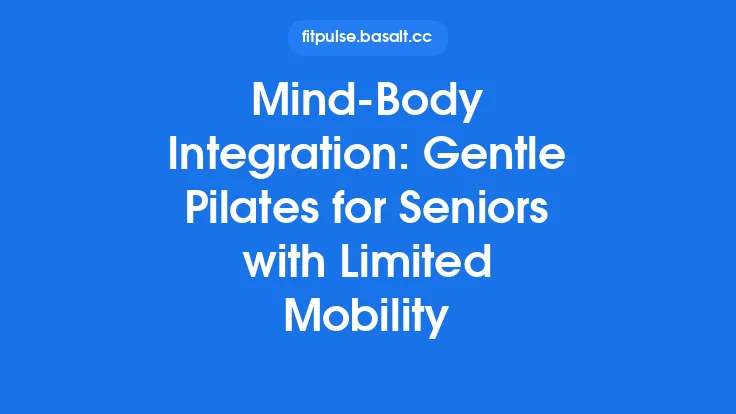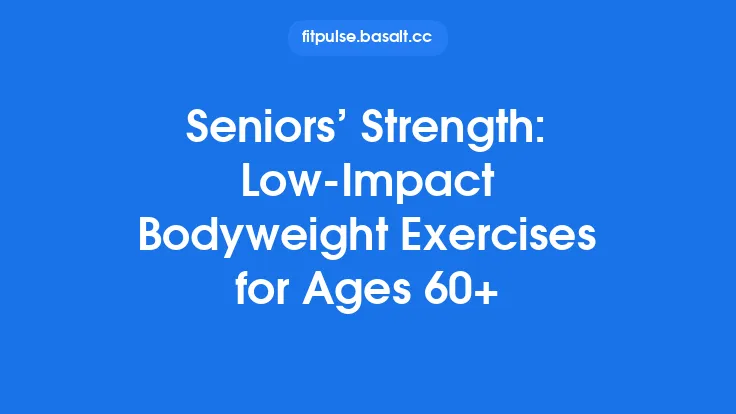Low‑impact full‑body workouts are an excellent way for seniors with limited mobility to stay active, preserve muscle mass, and support overall health without placing excessive stress on joints. By focusing on controlled movements, appropriate intensity, and safe progression, older adults can enjoy the benefits of a comprehensive exercise routine from the comfort of their own home.
Understanding Low‑Impact Exercise for Seniors
Low‑impact exercise refers to activities that minimize the force transmitted through the skeletal system while still engaging multiple muscle groups. For seniors with limited mobility, this approach reduces the risk of joint irritation, bruising, or over‑exertion. Key characteristics include:
- Smooth, fluid motions – avoiding sudden starts, stops, or jerky actions.
- Reduced ground reaction forces – staying mostly on the balls of the feet or using a wall for support rather than high‑impact foot strikes.
- Emphasis on range of motion – moving joints through comfortable, pain‑free arcs to maintain flexibility.
When these principles are applied consistently, the body experiences improved circulation, enhanced muscular endurance, and better joint lubrication—all without the wear‑and‑tear associated with high‑impact activities.
Core Principles of a Safe Full‑Body Routine
- Progressive Overload with Caution – Gradually increase the difficulty (e.g., more repetitions, slightly heavier objects) while monitoring how the body feels.
- Joint‑Centric Alignment – Keep knees, hips, and shoulders aligned with the direction of movement to protect vulnerable joints.
- Breath Coordination – Inhale during the preparatory phase, exhale during the exertion phase; this stabilizes the core and reduces intra‑abdominal pressure.
- Use of External Support – A sturdy countertop, wall, or sturdy chair can provide balance assistance without turning the exercise into a dedicated balance drill.
- Pain‑Free Threshold – Any movement that provokes sharp or lingering pain should be modified or omitted.
Essential Warm‑Up Movements
A brief, low‑intensity warm‑up prepares the cardiovascular system, raises muscle temperature, and primes the nervous system for the upcoming work. Aim for 5–7 minutes of gentle activity:
| Movement | Reps / Duration | Focus |
|---|---|---|
| Marching in place (slow, heel‑to‑toe) | 30 seconds | Increases heart rate, warms lower limbs |
| Arm circles (small to medium) | 10 each direction | Mobilizes shoulder girdle |
| Neck tilts (side‑to‑side) | 5 each side | Relieves tension in cervical region |
| Ankle pumps (alternating up‑and‑down) | 10 each foot | Enhances ankle mobility |
| Torso twists (standing, hands on hips) | 8 each side | Engages core and spinal rotation |
Perform each movement within a comfortable range; the goal is to feel a gentle warmth, not fatigue.
Standing Strength Moves for Major Muscle Groups
These exercises target the primary muscle groups while keeping impact low. Use light hand‑held objects (e.g., 1–2 lb water bottles) or simply rely on body weight. Perform 2–3 sets of 8–12 repetitions, resting 30–45 seconds between sets.
1. Wall‑Supported Squat (Partial)
Start: Stand facing a wall, feet hip‑width apart, hands lightly resting on the wall at chest height.
Action: Bend knees slightly, shifting weight back as if sitting onto an invisible chair, keeping thighs parallel to the floor or higher if needed. Press through the heels to return to standing.
Key Points: Keep knees tracking over the toes, avoid excessive forward lean.
2. Heel‑Raised Calf Lift
Start: Stand behind a sturdy chair, lightly holding the back for balance.
Action: Rise onto the balls of the feet, lifting heels as high as comfortable, then lower slowly.
Key Points: Maintain a straight line from knees to shoulders; avoid rocking forward.
3. Chest Press with Light Weights
Start: Stand with feet shoulder‑width apart, elbows bent, weights at chest level.
Action: Extend arms forward, pressing the weights away from the chest, then return to the starting position.
Key Points: Keep shoulders relaxed, avoid shrugging.
4. Reverse Lunge with Support
Start: Stand near a countertop, holding it lightly.
Action: Step one foot back, lowering the back knee toward the floor while keeping the front knee over the ankle. Return to standing and repeat on the opposite side.
Key Points: Limit depth to a comfortable range; use the support only for balance, not as a prop for the movement.
5. Overhead Reach and Pull‑Down
Start: Stand tall, arms extended overhead holding light weights.
Action: Pull elbows down toward the shoulders while keeping the arms straight, then extend back overhead.
Key Points: Engage the latissimus dorsi and shoulder stabilizers without excessive strain.
Gentle Cardio Alternatives Without Strain
Cardiovascular health can be maintained through low‑impact activities that keep the heart rate modestly elevated. The following options require minimal equipment and can be performed in a living‑room or hallway.
- Step‑Touch Walk – Step side‑to‑side, gently tapping the opposite foot across the body. Add a light arm swing for added calorie burn.
- Seated March (if standing is challenging) – Sit on a sturdy chair, lift one knee at a time, mimicking a marching motion.
- Low‑Impact Shadow Boxing – From a comfortable stance, throw slow, controlled punches (jab, cross) while rotating the torso slightly.
- Mini‑Cycle on a Pedal‑Assist Device – A compact, floor‑standing pedal exerciser allows leg movement without bearing full body weight.
Aim for 10–15 minutes of continuous movement, adjusting speed to keep breathing slightly elevated but still able to hold a conversation.
Integrating Light Resistance Safely
While the primary focus is low impact, adding modest resistance can enhance muscular strength and bone health. Consider the following options, all of which avoid the use of resistance bands (covered in a separate article) and heavy equipment.
- Water Bottles or Canned Goods – 1–2 lb containers are easy to grip and can be incrementally upgraded as strength improves.
- Light Ankle Weights (≤ 1 lb each) – Securely fastened, they add gentle load to leg movements without compromising joint alignment.
- Weighted Vest (lightest setting) – Distributes weight evenly across the torso, useful for those who can tolerate a small load during standing exercises.
When introducing resistance, start with a single set of each movement, focusing on perfect form. Only after mastering technique should additional sets or slightly heavier objects be added.
Cool‑Down and Stretching for Mobility Preservation
A purposeful cool‑down helps transition the body back to a resting state, reduces post‑exercise stiffness, and supports joint health. Spend 5–7 minutes on the following:
| Stretch | Hold | Target |
|---|---|---|
| Standing Quad Stretch (using wall for balance) | 15 seconds each side | Quadriceps |
| Chest Opener (hands clasped behind back, gently lift) | 20 seconds | Pectoral muscles |
| Seated Forward Fold (on a sturdy chair, reach toward toes) | 20 seconds | Hamstrings & lower back |
| Upper Back Stretch (arms extended forward, palms facing outward) | 15 seconds | Thoracic spine |
| Calf Stretch (hands on wall, one foot back, heel down) | 15 seconds each side | Calves |
Breathe deeply throughout each stretch, allowing the muscles to relax rather than forcing a deep pull.
Creating a Sustainable Weekly Schedule
Consistency is more valuable than occasional intensity spikes. A balanced weekly plan might look like:
| Day | Focus |
|---|---|
| Monday | Full‑body strength (standing moves) |
| Tuesday | Gentle cardio alternative |
| Wednesday | Rest or light mobility walk |
| Thursday | Full‑body strength (repeat) |
| Friday | Gentle cardio alternative |
| Saturday | Combination of light resistance and core activation |
| Sunday | Rest or optional gentle stretching session |
Adjust the order based on personal energy levels, weather, or other commitments. The key is to ensure at least two days of rest to allow muscular recovery.
Tracking Progress and Staying Motivated
- Simple Logbook – Record the date, exercises performed, number of repetitions, and any added weight. Seeing incremental improvements reinforces adherence.
- Perceived Exertion Scale – Rate each session on a 1–10 scale; aim for a moderate 4–6 level where effort is noticeable but not exhausting.
- Goal Setting – Short‑term goals (e.g., “increase wall‑supported squat depth by 2 inches”) provide tangible milestones.
- Social Accountability – Share progress with a family member, friend, or virtual community of seniors; encouragement boosts morale.
Common FAQs
Q: Can I perform these workouts if I use a walker?
A: Yes. Position the walker within easy reach for support during standing moves, but treat it as a balance aid rather than a prop that bears weight for the exercise itself.
Q: How do I know if the weight I’m using is appropriate?
A: The chosen object should allow you to complete the prescribed repetitions with the last two feeling challenging but still controllable. If you can’t maintain form, reduce the weight.
Q: Is it safe to combine these workouts with medication for hypertension?
A: Generally, low‑impact activity is beneficial for blood pressure management. However, consult your healthcare provider before beginning any new routine, especially if you have cardiovascular concerns.
Q: What if I feel mild joint soreness after a session?
A: Mild soreness is normal, but it should subside within 24–48 hours. Apply a warm compress, stay hydrated, and ensure you performed the cool‑down stretches. Persistent pain warrants a professional assessment.
Q: Can I increase the duration of cardio alternatives?
A: Yes, gradually add 2–3 minutes per week as endurance improves, keeping the intensity at a conversational level.
By adhering to these guidelines, seniors with limited mobility can enjoy a comprehensive, low‑impact full‑body workout that promotes strength, cardiovascular health, and joint preservation—all while minimizing the risk of injury. The emphasis on controlled movement, appropriate resistance, and consistent scheduling ensures that the program remains both safe and effective for long‑term wellness.





